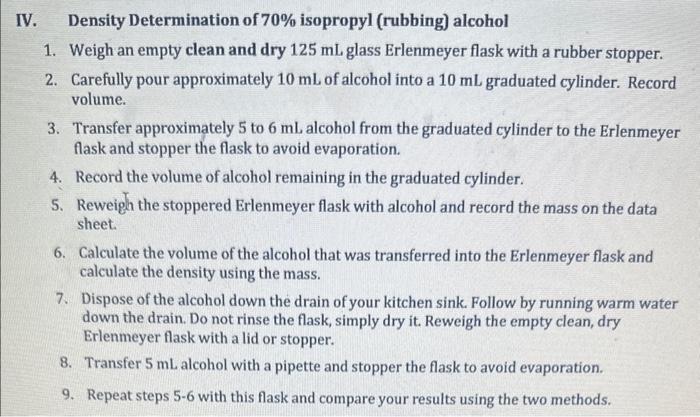V. Density Determination of 70% isopropyl (rubbing) alcohol 1. Weigh an empty clean and dry 125mL glass Erlenmeyer flask with a rubber stopper. 2. Carefully pour approximately 10mL of alcohol into a 10mL graduated cylinder. Record volume. 3. Transfer approximately 5 to 6mL alcohol from the graduated cylinder to the Erlenmeyer flask and stopper the flask to avoid evaporation. 4. Record the volume of alcohol remaining in the graduated cylinder. 5. Reweigh the stoppered Erlenmeyer flask with alcohol and record the mass on the data sheet. 6. Calculate the volume of the alcohol that was transferred into the Erlenmeyer flask and calculate the density using the mass. 7. Dispose of the alcohol down the drain of your kitchen sink. Follow by running warm water down the drain. Do not rinse the flask, simply dry it. Reweigh the empty clean, dry Erlenmeyer flask with a lid or stopper. 8. Transfer 5mL alcohol with a pipette and stopper the flask to avoid evaporation. 9. Repeat steps 5-6 with this flask and compare your results using the two methods. \begin{tabular}{|l|l|} \hline Mass of empty flask + stopper + isopropyl alcohol (g) & \\ \hline Mass of empty flask + stopper (g) & \\ \hline Mass of isopropyl alcohol (g) \\ \hline Initial volume in graduated cylinder (mL) \\ \hline Final volume in graduated cylinder (mL) \\ \hline Delivered volume (mL) (Initial- final) \\ \hline \\ Calculated density (show calculation) \end{tabular} V. Density Determination of 70% isopropyl (rubbing) alcohol 1. Weigh an empty clean and dry 125mL glass Erlenmeyer flask with a rubber stopper. 2. Carefully pour approximately 10mL of alcohol into a 10mL graduated cylinder. Record volume. 3. Transfer approximately 5 to 6mL alcohol from the graduated cylinder to the Erlenmeyer flask and stopper the flask to avoid evaporation. 4. Record the volume of alcohol remaining in the graduated cylinder. 5. Reweigh the stoppered Erlenmeyer flask with alcohol and record the mass on the data sheet. 6. Calculate the volume of the alcohol that was transferred into the Erlenmeyer flask and calculate the density using the mass. 7. Dispose of the alcohol down the drain of your kitchen sink. Follow by running warm water down the drain. Do not rinse the flask, simply dry it. Reweigh the empty clean, dry Erlenmeyer flask with a lid or stopper. 8. Transfer 5mL alcohol with a pipette and stopper the flask to avoid evaporation. 9. Repeat steps 5-6 with this flask and compare your results using the two methods. \begin{tabular}{|l|l|} \hline Mass of empty flask + stopper + isopropyl alcohol (g) & \\ \hline Mass of empty flask + stopper (g) & \\ \hline Mass of isopropyl alcohol (g) \\ \hline Initial volume in graduated cylinder (mL) \\ \hline Final volume in graduated cylinder (mL) \\ \hline Delivered volume (mL) (Initial- final) \\ \hline \\ Calculated density (show calculation) \end{tabular}








